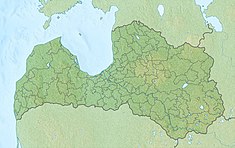Pļaviņas Hydroelectric Power Station

Multi tool use
| Pļaviņas Hydroelectric Power Station | |
|---|---|
 | |
 Location of Pļaviņas Hydroelectric Power Station in Latvia | |
| Location | Aizkraukle |
| Status | Operational |
| Opening date | 1965 (1965) |
| Power Station | |
| Coordinates | 56°35′00″N 25°14′30″E / 56.58333°N 25.24167°E / 56.58333; 25.24167Coordinates: 56°35′00″N 25°14′30″E / 56.58333°N 25.24167°E / 56.58333; 25.24167 |
| Operator(s) | Latvenergo |
| Commission date | 1968[1] |
| Type | Conventional |
| Turbines | 10 |
| Installed capacity | 894 MW[1] |
| 2016 generation | 1,386 GWh[1] |
The Pļaviņas Hydroelectric Power Station has the largest hydroelectric power plant in the Baltics and one of the biggest in the European Union. It is located in Aizkraukle on the Daugava River. It has ten individual water turbines with an installed total capacity of 894 MW.[1][2]
The construction aroused an unusual wave of protest in 1958. Most Latvians opposed the flooding of historical sites and a particularly scenic gorge with rare plants and natural features, such as the Staburags, a cliff comparable in cultural significance to the Lorelei in Germany. The construction of the dam was endorsed in 1959, however, after the purge of relatively liberal and nationally oriented leaders under Eduards Berklavs and their replacement by Moscow-oriented, ideologically conservative cadres led by Arvīds Pelše.
The plant was put into full operation in 1968. In 1991–2001, six additional turbines were added to the original four, thus increasing the capacity to 868.5MW. Reconstruction and overhaul of the units between 2007 and 2010 increased both the efficiency of the plant and its power output.[1]
The complex is operated by Latvenergo.
References
^ abcde
"HPPs". Latvenergo. Retrieved 2018-05-15..mw-parser-output cite.citation{font-style:inherit}.mw-parser-output q{quotes:"""""""'""'"}.mw-parser-output code.cs1-code{color:inherit;background:inherit;border:inherit;padding:inherit}.mw-parser-output .cs1-lock-free a{background:url("//upload.wikimedia.org/wikipedia/commons/thumb/6/65/Lock-green.svg/9px-Lock-green.svg.png")no-repeat;background-position:right .1em center}.mw-parser-output .cs1-lock-limited a,.mw-parser-output .cs1-lock-registration a{background:url("//upload.wikimedia.org/wikipedia/commons/thumb/d/d6/Lock-gray-alt-2.svg/9px-Lock-gray-alt-2.svg.png")no-repeat;background-position:right .1em center}.mw-parser-output .cs1-lock-subscription a{background:url("//upload.wikimedia.org/wikipedia/commons/thumb/a/aa/Lock-red-alt-2.svg/9px-Lock-red-alt-2.svg.png")no-repeat;background-position:right .1em center}.mw-parser-output .cs1-subscription,.mw-parser-output .cs1-registration{color:#555}.mw-parser-output .cs1-subscription span,.mw-parser-output .cs1-registration span{border-bottom:1px dotted;cursor:help}.mw-parser-output .cs1-hidden-error{display:none;font-size:100%}.mw-parser-output .cs1-visible-error{font-size:100%}.mw-parser-output .cs1-subscription,.mw-parser-output .cs1-registration,.mw-parser-output .cs1-format{font-size:95%}.mw-parser-output .cs1-kern-left,.mw-parser-output .cs1-kern-wl-left{padding-left:0.2em}.mw-parser-output .cs1-kern-right,.mw-parser-output .cs1-kern-wl-right{padding-right:0.2em}
^ "Project - Pļaviņas". EBRD. 18 August 2005. Archived from the original on 2012-03-14. Retrieved 2010-01-09.
External links
@media all and (max-width:720px){.mw-parser-output .mobile-float-reset{float:none!important;width:100%!important}}.mw-parser-output .stack-container{box-sizing:border-box}.mw-parser-output .stack-clear-left{float:left;clear:left}.mw-parser-output .stack-clear-right{float:right;clear:right}.mw-parser-output .stack-left{float:left}.mw-parser-output .stack-right{float:right}.mw-parser-output .stack-object{margin:1px;overflow:hidden}
This article about a Latvian building or structure is a stub. You can help Wikipedia by expanding it. |
This article about a hydroelectric power plant is a stub. You can help Wikipedia by expanding it. |
QoD8eGlsIkdWxYQ,k fDWBEhjTh1utYtqG